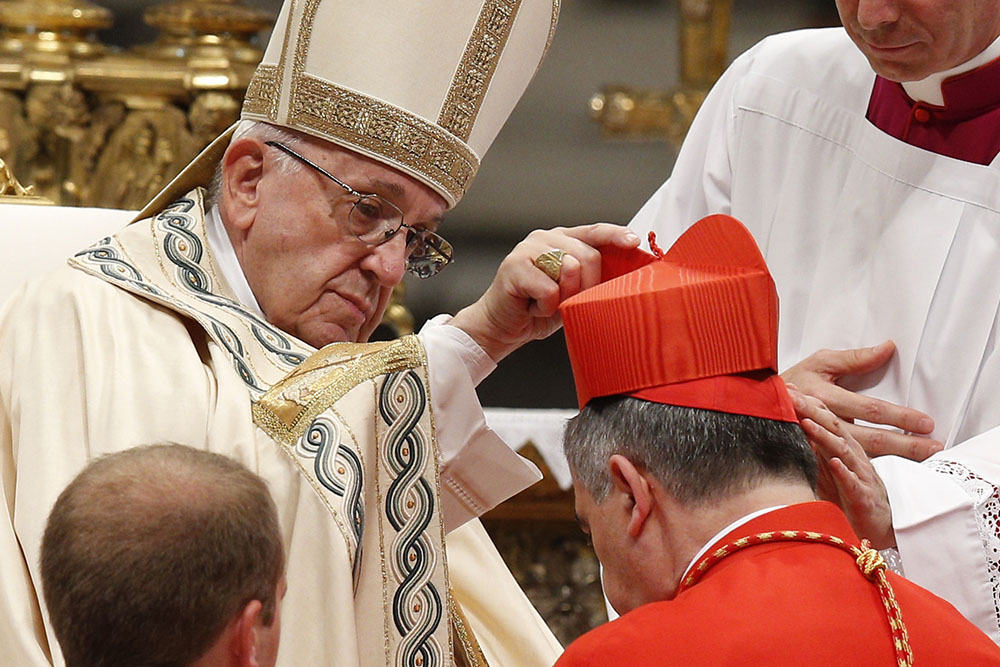
In St. Peter's Basilica at the Vatican in 2018, Pope Francis place a red biretta on Cardinal Giovanni Angelo Becciu, then Vatican substitute secretary of state, during a consistory at which Becciu and 13 others became cardinals. (CNS/Paul Haring)
There is an old saying among hierarchs in the Catholic Church: Rome is known as the Eternal City because it takes an eternity to accomplish anything in the Vatican Curia. Yet, eight years into his pontificate, Pope Francis' determination to reform the Curia is showing signs of success.
Investigative reporter Jason Berry published a deep dive here at NCR yesterday into the issues surrounding the trial of Cardinal Giovanni Angelo Becciu. That trial started this week and it is, in itself, a remarkable event.
Cardinals are not called "princes of the Church" for nothing, and Becciu had acquired more power than most: In his previous role as sostituto at the Vatican's Secretariat of State, he functioned somewhat like a White House chief of staff. On paper, both roles do not appear as consequential as they are, but in practice, both serve at critical choke points for virtually all decision-making.
In previous pontificates, Becciu's cardinal's hat would have been enough to shield him from prosecution. If, before Francis, Becciu had been caught doing something illegal or even terribly wrong, he might have been posted to a different job, and given a sinecure, the way Cardinal Bernard Law was named archpriest of Santa Maria Maggiore after he resigned as archbishop of Boston in 2002.
Now Becciu is on trial. Every other cardinal has gotten the message: Being a cardinal will not protect you from the consequences of your own actions.
The trial is not the only evidence of Francis' efforts to drag the Roman Curia kicking and screaming into at least the 20th century. Last week, the Administration of the Patrimony of the Holy See (APSA) published not only a fiscal report for the Vatican but, for the first time, a list of the real estate owned by the Vatican, more than 4,000 properties in Italy and another 1,200 abroad. Light is the enemy of corruption.
In addition to this new level of transparency about its finances, we also learned how the church navigated the pandemic in its role as a landlord. Rents were reduced and deferred to help tenants survive the economic fallout of the shutdowns. APSA's president, Bishop Nunzio Galantino, said the reductions resulted in the Holy See's accounts being in the red last year, but also in "a positive result in the sense that it has brought out the will to be and continue to be and behave 'as a church,' even in a moment of serious crisis for everyone."
One of the negative aspects of increased lay involvement in ecclesial decision-making, at least in the United States, has been the introduction of MBA-think. Many bishops will tell you that their lay advisers often complain about the bishop's decisions by saying, "You couldn't run a business like that," and the bishop has to point out that the church is not, after all, a business.
In addition to these two recent, particular signs of change in the Vatican's way of conducting itself, we are all awaiting the publication of Praedicate Evangelium, the apostolic constitution that will reshape the structure of the Vatican. It will be the result of unprecedented consultation and, hopefully, will concretize some of the changes in attitude that the Holy Father has sought in his efforts to more fully implement the vision of the Second Vatican Council: Less clericalism and secrecy, more synodality and transparency. You might call these different efforts Francis' "reform of the reform."
Advertisement
The goal Francis seeks is not merely a Vatican less plagued by intrigue, infighting and scandal, but a Vatican that is modeling for the universal church the evangelizing impulse that emerges from a reading of the Gospel.
The pope is not a primitivist, to be sure. He seeks the exact same kind of genuine reform Pope Benedict XVI spoke of in his often misquoted 2005 address to the Curia, one that entails elements of both continuity and discontinuity with the immediate past, retrieving the insights and inspirations of the early church while facing squarely the problems of our own time.
We humans are creatures of habit. When you combine that human desire for constancy with a faith that is rooted in an apostolic tradition, you get an organization that is necessarily, and often usefully, resistant to change.
Francis understands that in order to change an entrenched subculture like that of the Vatican Curia, you need to change procedures and policies, sometimes personnel, but most of all, you have to change direction — get the organization moving toward new goals for which their old habits and methods will not work, so that the personnel make the new procedures their own.
In the past few days, we have seen evidence of the tectonic shifts Francis has been setting in motion. Once in motion, they will be much harder to turn back.




